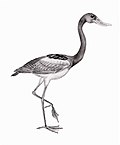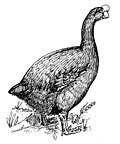| Manuherikia Temporal range: Early Miocene | |
|---|---|
| Scientific classification | |
| Domain: | Eukaryota |
| Kingdom: | Animalia |
| Phylum: | Chordata |
| Class: | Aves |
| Order: | Anseriformes |
| Superfamily: | Anatoidea |
| Family: | Anatidae |
| Subfamily: | † Dendrocheninae Livezey & Martin 1988 |
| Genus: | † Manuherikia Worthy et al., 2007 |
| Species | |
Manuherikia is a genus of extinct species of ducks from the Miocene of New Zealand. It was described from fossil material of the Saint Bathans Fauna, in the lower Bannockburn Formation of the Manuherikia Group, found by the Manuherikia River in the Central Otago region of the South Island. The genus name comes from the name of the geological formation in which the fossils were found and, ultimately, from the Manuherikia River and its valley. [1]

